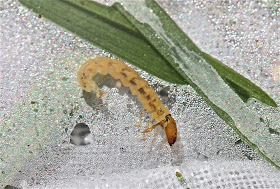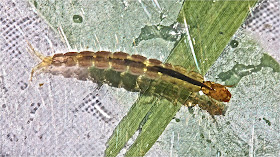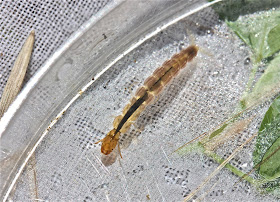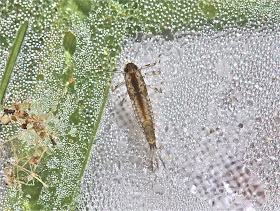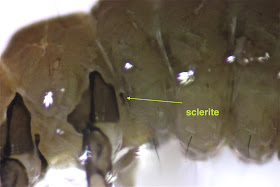Thursday, May 31, 2012
Netspinner Day: Common, Fingernet, and Trumpetnet -- All Three
Along with a friend, I went to a small stream in Sugar Hollow this morning, and we soon agreed that it's probably time to start looking elsewhere if we want to see the new species that show up in the summer.
In these little streams that flow down the mountains and feed into the Moormans the water levels are dropping, and a lot of the insects that flourish here in the winter and spring have hatched and laid their eggs, setting the stage for a new generation. Oh, we did find plenty of insects -- just nothing new and unexpected. The list: flatheaded mayflies, Epeorus pleuralis; the Perlodid stoneflies, Isoperla holochlora and Remenus bilobatus; genus Eccoptura common stoneflies; "baby" Peltoperlids (Roach-like stoneflies), and "baby" Giant stoneflies; and a few Leuctrids -- "Rolled-winged" stoneflies. A few other things, but that's all.
I also found the common netspinner in the photo above, Diplectrona modesta, and a fingernet caddisfly larva, genus Dolophilodes. Both of these "netspinning" caddisfly larvae are intolerant of stream impairment, and we've seen them in these Moormans' tribs before.
Diplectrona modesta:
Fingernet (Philopotamidae), genus Dolophilodes:
On my way back into town, I decided to take a look in the Moormans River itself, where I hoped to see some small minnow mayflies. I didn't. What I did see was something that we often see in the summer in a lot of our streams, a lot of common netspinners, genus Hydropsyche, a fairly tolerant taxon, and a trumpetnet caddisfly larva. The common netspinners were, by far, the dominant taxon in this part of the stream. I see very few of them in the winter, and while numbers increase in the spring, it's in the summer that they seem to flourish in this part of the country.
The common netspinners I saw in the Moormans were different colors -- some gray/brown, others bright green, others still more the color of olive. I suspect they were all Hydropyche in terms of the genus -- that's the most common genus we see -- but the colors and patterns may indicate a difference in species. The North Carolina list of tolerance values has numbers for 12 different species of Hydropsyche, with values ranging from 2.6 to 7.9. Some day, I hope I can figure out which species we find in our streams, but that's a project that's going to take me some time.
This is one that I like to see -- and see it quite often -- because of the pattern.
While the abdominal gills are very clear in this photo, they show up even better when these larvae roll onto their backs -- something they like to do.
This is a photo that also reveals the features that help us determine the genus ID -- the two "sclerites" (dark spots) at the base of the prosternal plate, along with a forked fore trochantin, indicate Hydropsyche.
The trumpetnet caddis (Polycentropodid) has none of those "frilly" gills on its belly. But we can tell what it is when we see the dark spots ("muscle scars") on top of its head. This too is a tolerant caddis, but it's not one that seems to be common in the streams that I visit.
I did find a mayfly nymph in the Moormans about which I was very excited -- the flatheaded mayfly, genus Stenacron. This is the first one that I've seen this year. Unfortunately, while it was swimming around in my bowl, it managed to lose one of its legs and break off part of its tail! But, it's still worth a look for its beautiful colors.
_____________
I also got some photos of one of the Leuctrids that I found in the small stream where we started this morning, and they too are worth a look.
I'm starting to think that the wing pads lighten in color like this right before they turn black.
Monday, May 28, 2012
And the First Small Minnow Mayfly to Show Up in Large Numbers Is....Baetis intercalaris
Well, at least at Buck Mt. Creek. I went looking for small minnow mayflies this morning, and I found them, and I found a fair number. They were all the same species, Baetis intercalaris. This is a small minnow species I saw in a lot of our streams all summer last year, and well into the fall. It's a species that's easy for us to identify right on the spot -- with some form of magnification -- because of it has two features that are easy to see: 1) on just about every tergite there are pale, submedian "parenthese marks,"
( ), and 2) the banding on the tails is unique. There are three gray bands on the tails, the first right at the base of the cerci. (Click to enlarge)
This is a live photo, seen through a macro lens. Needless to say, the parentheses marks show up a lot better in a microscope view.
Baetis intercalaris is a tolerant insect, with a TV of 5.0. It is also commonly found in our streams: Beaty calls it "ubiquitous" (Steven Beaty, "The Ephemeroptera of North Carolina," p. 6).
Since it is so common, I decided to see what Knopp and Cormier (Mayflies, pp. 46-47) had to say about this "Blue-winged Olive" nymph (to fly fishermen). I was a little surprised.
"Baetis tricaudatus is...one of the first mayflies to hatch across the East-Midwest region and usually appears during early April, or when water temperatures have climbed to the low 40's. B. intercalaris is the second East-Midwest species of this complex to emerge, doing so about two to three weeks after the first of the B. tricaudatus hatches."
Hmm.... So, why am I just starting to find them? And, the nymphs that I'm finding are small. I find this perplexing. They give a hatch range of mid-March to mid-June for this species. Yet, most of the mature nymphs I saw last year, I saw in August and September -- like this one, I found on September the 12th.
However, I do have to note that the very first B. intercalaris nymph that I found last year, I found on May 11th (Powells Creek), and it was fairly mature This one.
I guess it's possible that B. intercalaris is bi-brooded: hatching in spring, laying their eggs, which as nymphs grow up over the summer, and then those nymphs hatch in late summer and fall. If I find out more about this, I'll let you know. (But Knopp and Cormier give no indication that that is so.)
____________
I found one other insect of interest this morning, a flatheaded mayfly which I mistook -- as I've done before -- for a Heptagenia marginalis. This is the nymph in question.
Since I was not really certain of my ID, I preserved this nymph and took a close look at home with my microscope. And what did it turn out to be? Cinygmula subaequalis, the same flatheaded species that I found, for the first time, at South river on 4/27! What gives this away, you may recall, is the fact that the maxillary palps are actually visible sticking out to the sides of the head when you look at the head from above. Like this:
(Sorry that I could not get a good shot showing the palps on both sides of the head. Better photo below taken on 4/27.)
___________
Other photos from today's trip.
1) Flatheaded mayfly, Epeorus vitreus -- with a head that was surprisingly narrow, or a thorax that was abnormally wide.
And 2) a Flatheaded mayfly, genus Leucrocuta, a very small one. (We might think of this as the "fatheaded" flathead!)
________
But best to finish with some more shots of one of the Baetis intercalaris nymphs.
Sunday, May 27, 2012
Drunella cornutella: A New Spiny Crawler at the Upper Doyles River
I had no idea what to expect when I went to the Upper Doyles river this morning, but I ended up being very pleased with the results. While I still found the occasional Ephemerella dorothea spiny crawler, the find of the day was this new -- for me -- species, Drunella cornutella. The prominent tubercles on the leading edge of the robust fore-femora tell us the genus. For the species ID, we turn to Steven Beaty's "The Ephemeroptera of North Carlina," p. 25. There we read:
D. cornutella -- nymphs 6.4-8.5 mm; head smooth with moderately long lateral frontoclypeal projections but less than half as long as the distance between them; median ocellar tubercle blunt to moderately sharp; femora with dense row of long, fine setae on posterior margin; ratio of mesotibia to mesofemur < 0.85; abdomen without paired dorsal tubercles. Collected in spring through early summer. Common.
That's a lot to remember, so let's look at one thing at a time.
1) the long lateral frontoclypeal projections:
No question about that.
2) the median ocellar tubercle (bump) -- blunt":
Check.
3) "dense row of long, fine setae on posterior margin," of the femora, and "ratio of mesotibia to mesofemur < 0.85":
We can see the setae in this photo, and we can at least estimate the ratio of tibia to femur. I'd say that it is, indeed, less than 0.85. (I've now measured: the tibia is 1.1 mm, the femur is 1.8 mm, which gives a ratio of 6.1.)
4) no tubercles on the abdominal segments (they would project from the hind margins of the segments):
There you have it -- Drunella cornutella. North Carolina assigns of tolerance value of 0.0 to this spiny species. But before leaving the issue of species ID, let me note that D. cornutella can be confused with Drunella cornuta: they differ in only three ways. 1) D. cornuta nymphs range from 7.8 -- 11.4 mm in size, larger than D. cornutella: our nymph was not much more than 6 mm long. 2) The ocellar tubercle on D. cornuta is sharp, ours, as we've noted -- and illustrated -- is "blunt to moderately sharp." And 3) on D. cornuta nymphs the ratio of mesotibia to mesofemur is "> 0.85, usually closer to one." I'd say the nymph that I found this morning was definitely D. cornutella -- the tibia appears to be considerably shorter than the femur.
This means that we have now found three different species of the spiny crawler Drunella in local streams: D. tuberculata, D. walkeri, and D. cornutella. For the entries on D. walkeri and D. tuberculata -- both species found in the lower Doyles River and Buck Mt. Creek -- look back the entries posted on 4/9, 4/17, and 4/23.
________
In the leaf packs today, I continued to find lots of I. holochlora Perlodid stoneflies, while the flatheaded mayflies Epeorus vitreus and Epeorus pleuralis continue to crawl on the bottoms of rocks. But the tops of the rocks were covered with Glossossomatids (Saddle-case-maker caddisfly larvae). The Glossossomatid was, by far, the most common insect that I saw today, so I checked to see what Thomas Ames (Caddisflies: A Guide to Eastern Species for Fly Fishermen and Other Naturalists) had to say about when they're around. (As I've noted before, I primarily think of these cases as something we only see in the winter.) Well, it turns out that there can be two major hatches of Glossos, one in the spring and one in late summer (Ames, p. 94), so naturally, we'll be seeing the cases first in the winter and then in late spring.
I picked up three cases today, but by the time I got around to taking my photos, all three larvae were desperate to escape. (That's an I. holchlora Perlodid clinging to the side of the case.)
And before long, two of the larvae were out and curled up in the tray.
If you enlarge this photo (click on it), you'll be able to see one of the distinguishing features of this caddisfly larva: the anal prolegs are short and stubby. Actually, most of the proleg is fused with the final abdominal segment. This shows up well in this microscope photo, as does the characteristic "sclerite" on the dorsal side of segment 8.
The Glossossomatids we see in our streams are almost always Glossossomas (genus): there are no sclerites (dark marks) on the mesonotum. But I thought that today I'd see if I could key this one out to the level of species. It turned out to be easy. This is G. nigrior, which, Beaty notes, is the "only confirmed species in North Carolina" (Steven Beaty, "The Trichoptera of North Carolina," p. 7). Definition --
G. nigrior -- larvae 4-5 mm; pronotum with small black spot above forecoxae; small sclerites in intersegmental fold between thorax and first abdominal segment laterally.
Those features are pointed out in the following photos.
__________
Tomorrow, it's off to Buck Mt. Creek to see if there's any sign there of summer insects.
_________
More photos of Drunella cornutella.
Saturday, May 26, 2012
Chloroperlidae (Green Stonefly), genus Alloperla: Making the Case
I found this green stonefly (family: Chloroperlidae) on 5/17 in a very small -- but beautiful -- stream in Sugar Hollow, and on 5/18 I made a tentative call of genus Alloperla. This is an uncommon genus, one I've not seen before. But then two days ago I found a another one in the Doyles River. This one.
I now think it's possible that the immature Chloroperlid (pictured below) that I found at Buck Mt. Creek on 5/11 was an Alloperla as well, so I'm hopeful that I'll run into more of these in the near future.
In this entry, I'd like to make the best case I can for the identification of Alloperla using a detailed description, illustrated with some microscope photos I've taken. The description I'll use comes from the chapter on Chloroperlids -- "Chloroperlidae (The Sallflies)" -- by Rebecca F. Surdick, which is pp. 1-60 in Bill P. Stark and Brian J. Armitage (Editors), Stoneflies (Plecoptera of Eastern North America, Volume II: Chloroperlidae, Perlidae, and Perlodidae (Perlodinae) (Columbus, Ohio: Ohio Biological Survey, Inc., 2004). Surdick's words are in BOLD type. (See pp. 5-6 in her chapter).
(p. 5) Nymph. Habitus [body shape] more streamlined, elongate than other Chloroperlinae.
No doubt about it. It's the first thing I noticed when I found these nymphs. Two additional photos for making this point.
Compare this to the Chloroperlid that we saw all winter long, which was genus Sweltsa: note especially the different shape of the abdomen.
Surdick continues: Laciniae usually terminating in single tooth and comb of two to ten regularly spaced even-length spines (bristles.)
The single tooth and the comb of spines are clearly visible in this microscope photo.
Pronotum with fringe of single or clustered long setae, usually restricted to corners.
This is the best photo that I could get of the pronotum. Note that there are no setae on the anterior and posterior margins of the pronotum -- they're only at the corners. (The number and length of these "corner" setae, by the way, is important in determing species ID.)
Again, let's compare this to the pronotum of a Sweltsa nymph, which does have setae on the anterior and posterior margins (we'll just look at the posterior edge).
Wingpads nearly parallel to oblique on interior margins.
The "creamy" wingpads themselves appear to be parallel, but the inner margins -- edged in gold -- are clearly oblique. (And look at the wingpads on the nymph pictured at the top of the page.)
This is the best photo I could get of the tergites, and the body setae are so pale you can hardly even see them. If you click on the photo to enlarge it, you might be able to see some of the setae on the posterior margins of some of the tergites: I can't see any setae in the middle (medially).
Compare this with the relatively "hairy" body of a Sweltsa nymph, on which the setae on the posterior margins of the tergites is very easy to see. (Click on the photo to enlarge it.)
Even hairier, the wingpads and abdominal segments of this very young Sweltsa nymph.
Cerci usually plumate; each segment on distal two-thirds with one to a few dorsal and ventral long setae extending posteriorly from posterior margin and as long as to longer than segment, usually with delicate intercalary hairs in dorsal and ventral longitudinal row.
This is a difficult photo to get. To see the "plumate" character of the ends of the tails -- produced by the presence of intercalary (i.e. inter-segmental) hairs, you must have a lateral view of the tails, i.e. you have to turn the nymph on its side. The photo that follows is not very good, but it's the best I could get.
The cerci in the photo above are those of the nymph that I found on Thursday. As I noted before, I was not able to see these intercalary hairs on the nymph that I found on 5/17. What are clear on the 5/17 nymph, however, are the "few dorsal and ventral long setae," that extend "posteriorly from the posterior margin and [are] as long as to longer than [the] segment."
Why the tails on some of our nymphs do appear to be plumate while those on others do not is something I'm working on with a friend. However, both Surdick and Stewart and Stark (Nymphs of North American Stonefly Genera, p. 253), say that this fringe is usually present. Perhaps this varies with species.
I will not attempt to identify our Alloperlas to the level of species. Beaty notes that of the seven species of Alloperla in North Carolina "most of these species are undescribed." (Beaty, "The Plecoptera of North Carolina," p.9). Obviously, a lot of work remains to be done by entomologists on this genus of Chloroperlid. In Virginia, by the way, according to Stewart and Stark (p. 256) there are at least ten species of Alloperla: A. atlantica, A. banksi, A. biserrata, A. caudata, A. chloris, A. idei, A. imbecilla, A. nanina, A. neglecta, and A. usa. A. petasata should probably be added to make it eleven. Descriptions and illustrations of A. caudata, A. chloris, A. idei, A petasata, A. usa, A. voinae, and A. vostoki can be found in Bill P. Stark & Boris C. Kondratieff's article, "Larvae of Eight Eastern Nearctic Allopera Species (Plecoptera: Chloroperlidae)," which is available online at: http://www2.pms-lj.si/illiesia/papers/Illiesia06-20.pdf.
_________


